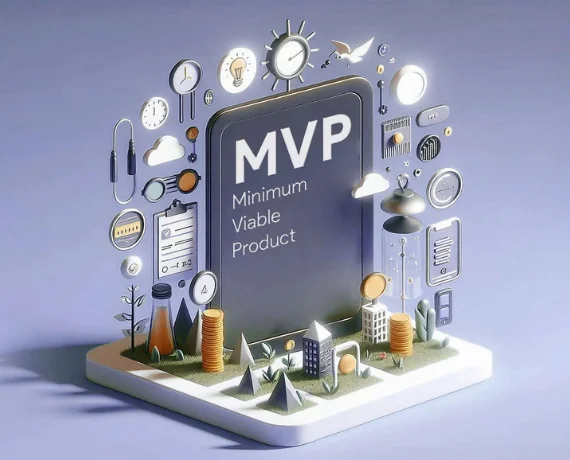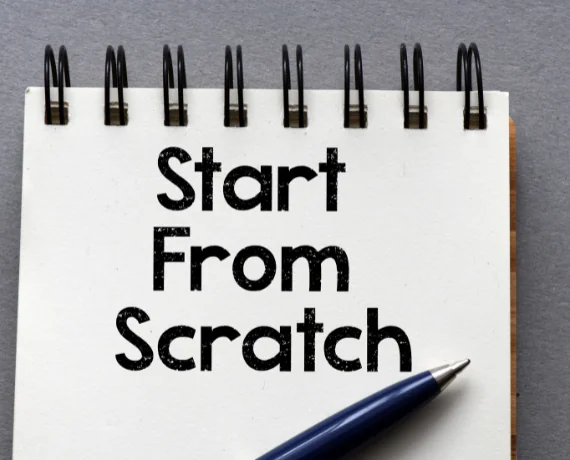Table of Content
- Introducing MVP
- What does MVP mean in Software Development?
- Why Startups Should Create an MVP
- How to Build an MVP
- Defining Your Product
- How much does it cost to build an MVP?
- Measuring MVP Success
- Business Model and MVP
- When Is It Time to Move from MVP to a Full-Scaled Product?
- Сonclusion
Looking for an MVP software development company?
Book a callMVP (minimum viable product) is such a stage of development of a startup or IT product when it solves at least one significant problem of users (clients) and, in this way, demonstrates its “viability”. Maintaining the product’s quality during the MVP development process is crucial to avoid budgetary impacts and ensure smooth operations. At the MVP stage, the product has users who may praise or strongly criticize it but still use it, thus confirming the existence of a need that the product satisfies. And in the opposite direction: if, at the MVP stage, the product does not solve important user tasks or solves them poorly, then such a product is not needed by the market and is ultimately “unviable”. Let’s explore the steps to building an MVP, from identifying core features to testing and refining your product.
Introducing MVP
A Minimum Viable Product (MVP) is a product development strategy that involves creating a basic version of a product with only the essential features to test its viability in the market. Think of it as the simplest form of your product that still delivers value to users. The MVP concept is based on the idea of launching a product quickly and with minimal resources to gather feedback from early adopters and iterate on the product.
The goal of an MVP is to achieve product-market fit by identifying the core features that meet the needs of the target audience. By focusing on only the essential features, you can test your product idea without investing too much time or money upfront. This approach allows you to validate your business idea and make data-driven decisions about future development.
MVP development involves a step-by-step process that includes market research, defining the product, measuring success, and refining the business model. By following the MVP development process, businesses can reduce the risk of launching a product that may not meet market needs and increase the chances of success. In essence, an MVP helps you build a product that people actually want, without wasting resources on unnecessary features.
What does MVP mean in Software Development?
In software development, MVP stands for Minimum Viable Product. Think of it as your product’s simplest version that still provides users with real value. The goal is to build a basic version with just the essential features needed to solve a specific problem or meet a key need.
What does MVP mean in software development? The idea behind an MVP is to test your product idea quickly and with fewer resources. By focusing on the main features, you can get your product out there faster and start collecting feedback from actual users. This feedback shows you what’s working and what needs fixing. Assessing the technical feasibility during the MVP development process is crucial to ensure that the product concept can be effectively implemented and is viable for further investment and execution. In short, an MVP helps you validate your idea efficiently, so you can make smart changes based on what users want and need.
Launching an MVP allows you to get feedback from real users and understand whether the product is really interesting to the audience and what they need right now. An MVP is a working test version of a product in which only the main functions (sometimes even one) are implemented. Its capability and relevance are verified by receiving real user feedback. For instance, MVP for travel could be a simple app that offers basic features like booking flights and hotels. This allows you to test the core functionality and gauge user interest before adding more complex features like personalized recommendations or multi-language support. By understanding how do you develop an MVP, you can quickly validate your product’s value proposition.
Why Startups Should Create an MVP
From the moment of the idea of creating a new product, making a software development plan, to its successful implementation is a long way. Identifying the target market is crucial when developing an MVP, as it allows businesses to tailor their products to meet customer needs and make strategic decisions. So MVP is an important part of product creation. But what exactly are the benefits of building an MVP, and how do you get an MVP up and running so that it really delivers results? Knowing how to build an MVP and creating such a product automatically gives you the following benefits.
Get Funding
Investors don’t finance dreams, they finance businesses that have a chance to succeed. An MVP shows them that you’re not just another “great idea” on a napkin. It proves that you have a real product, even if it’s basic, and that people are using it. This is gold for investors. It means you’ve gone beyond the idea and validated your concept in the real world. MVP user feedback reinforces your pitch by demonstrating that you’re solving a problem that people actually have. In short, an MVP is your chance to show investors that you’re a serious contender.
Validate Startup Idea
Creating an MVP is a low-cost way to see if there’s real interest in your product before jumping headfirst into a full-fledged launch. By hosting the basic version, you can test the products with real people. Does it solve the problem they are concerned about? Does it resonate with your target audience? An MVP helps answer these questions and not waste time and money on an idea that might just be a big splash without anyone. The key is to focus on promising ideas, not just cool concepts.
Software Project Start Checklist
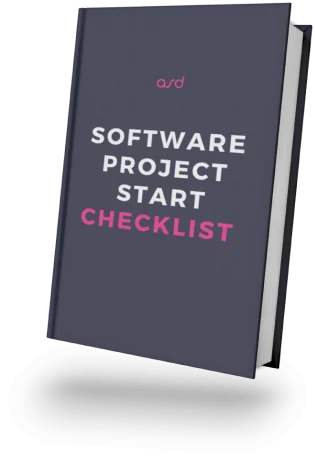

Reduce Risk
Creating a full product takes a lot of time and money. By starting with an MVP, you lower the risk. An MVP only has the basic features, so you don’t waste resources on things users may not want. This way, you can find and fix problems early in your MVP software development services. You can then change or improve your product based on what users say.
Optimize Development Process
Building an MVP for startups helps keep things simple and focused. By focusing only on the most important features, you can avoid extra complications and save time. This lets you launch your product faster and make changes based on what users say. Keeping the process simple also helps you use your resources better, saving money and making your development process more flexible.
Collect User Feedback
One of the best things about an MVP is that it lets you get feedback from real users. Collecting qualitative feedback in addition to quantitative feedback is crucial for a comprehensive understanding of user needs. By showing your MVP to people, you can find out what works and what needs fixing. This feedback helps you make your product better and make sure it fits what users want. Knowing how users interact with your MVP helps you make smart choices and focus on the features that matter most.
Looking for a tech partner for your MVP?
To put it simply, building an MVP is like selling toy cars. Instead of buying thousands of cars right away, you buy a few types to test first. This way is smarter and saves money. Just like with toy cars, you create a basic version of your product, show it to people, and get feedback to make it better. Focus on the key features and listening to feedback. This way, you will set up your product for a successful launch.
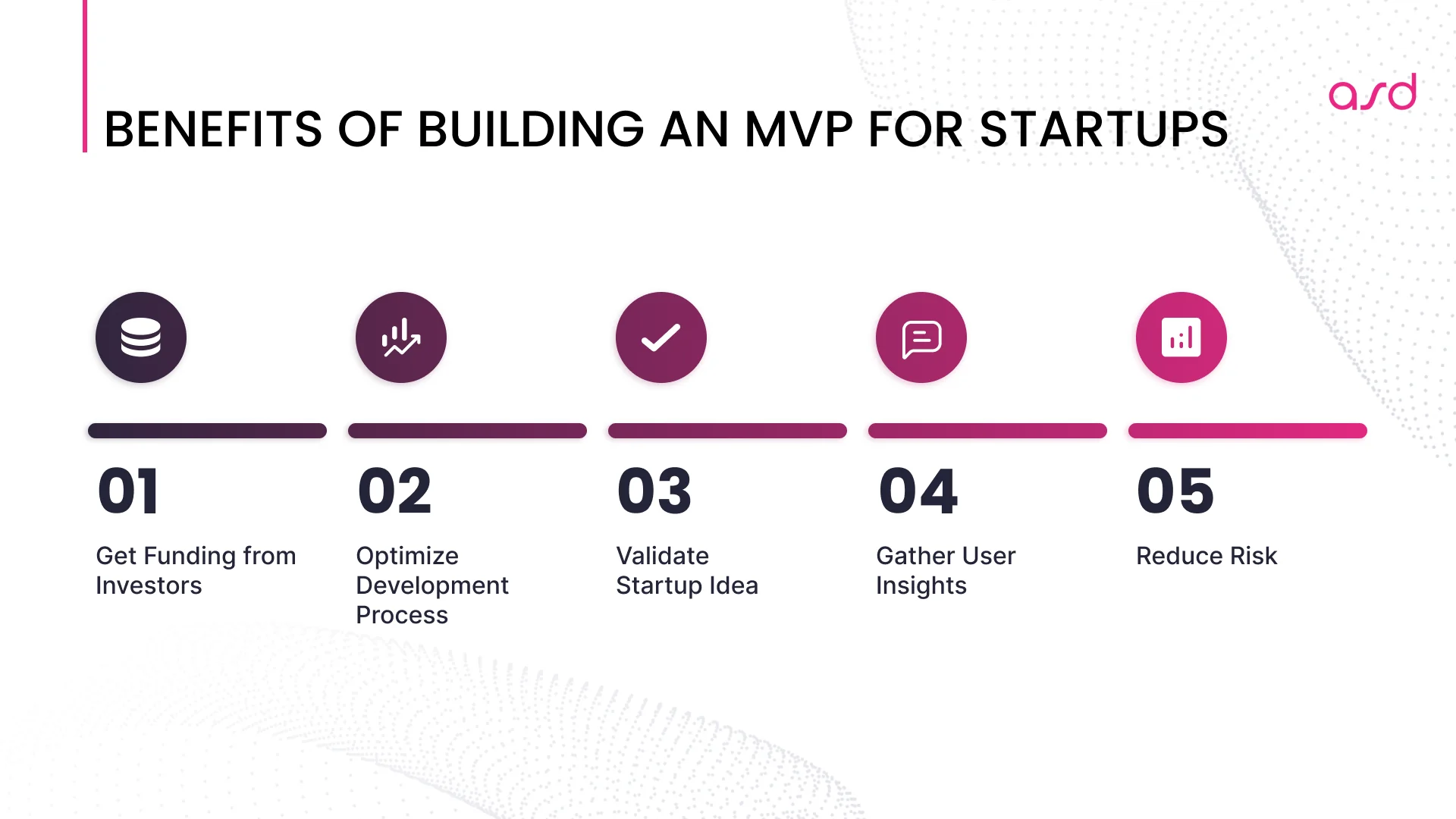
How to Build an MVP
There is no single instruction for building an MVP, as everything depends on the type of product, demand, and financial and resource capabilities of the company. However, we can illustrate the right approach for building an MVP.
Imagine you want to build a car. You think people would love to have a car. But building a whole car is expensive and time-consuming. So, before you spend a ton of money, you decide to test your idea first. You make a skateboard, which is a simple, basic version of a vehicle that can help people move faster. If people like and buy the skateboard, it shows that there’s a real need for faster transportation, and they’re willing to pay for it. Once you know that, you can start adding features to the skateboard to make it more like a car.
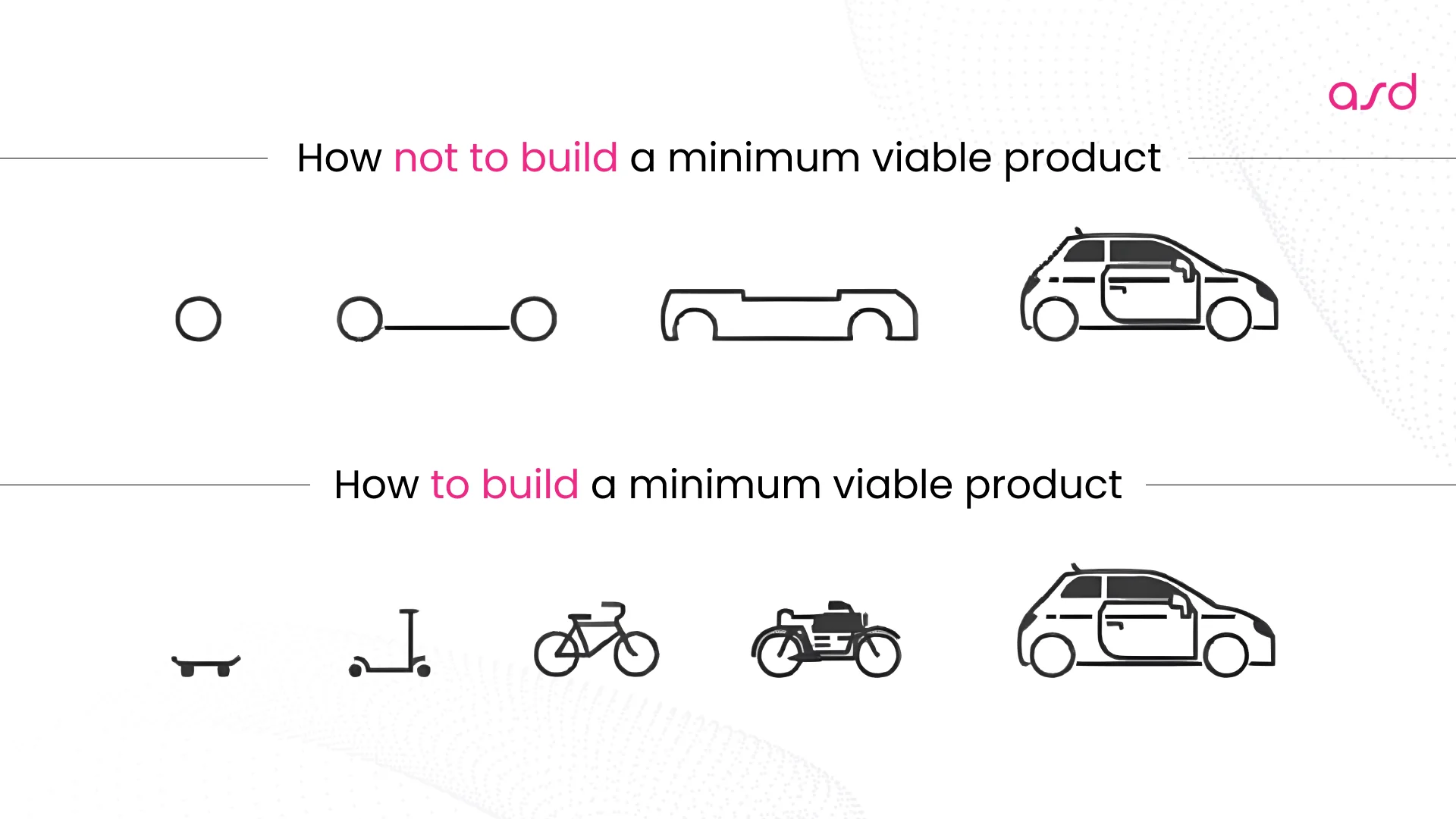
To help you navigate the complexities of product development, we provide a step-by-step guide for building an MVP.
Nevertheless, there are basic principles of creating a Minimum Viable Product that will help structure the work. Here’s a simple guide on how to build an MVP:
Step 1: Research the Market
Start by learning about the market. Understanding the user flow is crucial as it outlines the steps a user takes toward accomplishing a specific objective within a product. This means looking at the industry, finding gaps, and seeing what other products are out there. Check out existing solutions, their features, prices, and user feedback. Even if you managed to come up with something new or special, companies that offer something from the same industry may still be working in this niche. It is worth analyzing their market share, studying experience, learning advantages, identifying shortcomings, and understanding what makes them unique and why consumers choose them.
Step 2: Find Your Target Audience
Before you build your amazing thing, you gotta figure out who will use it most! Identifying your initial customers is crucial as they will provide valuable feedback and help you achieve product-market fit. Think about people who would be happy if your product existed. Are they kids, grown-ups, or maybe both? What do they like to do for fun? What problems do they have that your product could solve? Knowing this helps you make your thing even better for them!
Step 3: Make a Plan
Imagine your product is a giant sandwich, but you only have a few slices of bread and some fillings. You gotta pick the most important stuff to put in first, right? Same with your amazing product! Make a list of all the cool things it could do, then pick just a few of the most important ones. Prioritizing MVP features based on user needs and project goals ensures that your MVP is easier to build and prevents complexity and confusion in the final product. This way, people can still tell you if they like it. Then later, you can add more fillings, just like adding more features to your amazing thing!
Step 4: Prototype Before Development
Regardless of the scale of the future project, the MVP should present only the main functions. It is undesirable to offer the user additional features of the product immediately: this can confuse the client and distort the veracity of the results of the study of the feasibility of the idea. Advanced functionality can be added later, after testing the product and analyzing the feedback received.
Step 5: Choose Your Development Approach
Decide whether to develop your MVP in-house vs outsource the development. In-house development gives you more control over the process, similar to how you choose which games to play in your fort. However, this option may require more time and possibly additional assistance. Outsourcing, in turn, can be more cost-effective and provide access to specialized skills that your team may not have. Regardless of the choice, make sure that the partners you choose have the necessary experience and are easy to communicate with.
Step 6: Develop Your MVP
How to implement an MVP? Start by focusing on the most important features that you have identified as priorities. Ensure that the product can handle increased user demand as its popularity grows. Use a flexible approach to development that allows for incremental progress and adjustments as needed. It’s like building a fort: you build it in stages, making adjustments at each stage. Regularly review results and organize meetings to ensure that the project is moving in the right direction and meets your quality standards. Try to simplify the development process to avoid delays and complications. If something doesn’t work as planned, you can quickly make the necessary changes before you complete the main development.
Step 7: Testing and QA
The MVP should be tested throughout the development phase, regularly. Quality assurance is crucial during minimum viable product development to ensure the MVP meets user needs while avoiding unnecessary complexities. Alpha (internal) testing is done by the developer company’s testers, while beta (external) testing requires outside help. The ideal option is to attract a real audience of future users of the new product. You can find people willing to participate in testing on specialized platforms: BetaList, Quora, ProductHunt, Reddit, etc. You can also attract followers of your social networks, blog readers, use email newsletters.
The main task of testing is to technically improve the product so that occasional failures or imperfections do not prevent the audience from evaluating the functionality of the new product when it appears on the market.
Step 8: Launch and Grow!
Once your MVP is tested and ready, it’s time to show it off! The development stage is crucial in the product creation process, as it involves building essential features, analyzing user feedback post-launch, and iterating on the design based on market needs. Let people use it and tell you what they think. Are there ways to make it better? We can keep improving it based on their feedback, just like adding new blocks to your favorite building set. We’ll also track how well it’s doing (KPIs) to see if it’s growing and reaching more people.
In summary, building an MVP involves careful planning and execution through these key steps. By following these steps to build an MVP, you set up your MVP for a successful launch.

Defining Your Product
Defining your product is a crucial step in the MVP development process that involves identifying the core features and value proposition of the product. This step sets the foundation for your entire project, ensuring that you focus on what truly matters to your target audience.
The product definition should be based on market research and user feedback to ensure that it meets the needs of the target audience. This means understanding the pain points, preferences, and behaviors of your potential users. A good product definition should include the product’s mission, vision, and unique selling proposition (USP). These elements help clarify what your product aims to achieve and what sets it apart from existing solutions.
The product definition should also include the minimum viable product features that will be included in the initial launch. By focusing on only the essential features, you can ensure that your MVP development process is focused and effective. This approach allows you to test your core value proposition and gather valuable feedback from early adopters, which can then be used to refine and improve the product.
How much does it cost to build an MVP?
The cost of building an MVP can change during the development of the project. It is influenced by many factors. But there are basic costs that will need to be incurred in any case. Planning an initial budget will help you get started, even if the options are too limited. The bottom line is that at the planning stage, the price of developing an MVP is determined, taking into account some risks.
It is also crucial to evaluate development efforts in the context of the overall customer acquisition cost, as this helps in assessing the marketing performance alongside development investments.
Here’s why it’s hard to pinpoint a fixed cost:
-
Complexity of Your MVP
If your MVP has simple features, it will be cheaper to develop than one with complex functions. More complicated features mean more time and resources, which raises the cost.
-
Development Approach
Developing your MVP in-house with your own team will cost differently than outsourcing to another company. In-house costs include developer salaries, benefits, and equipment. Outsourcing costs can be fixed fees or hourly rates, depending on the vendor’s location and skills.
-
Team Expertise
The experience level and location of your development team can also influence cost. Highly skilled developers typically command higher rates, and developer rates can vary depending on geographic location.
Forming an initial budget is not so difficult. It consists of several cost items:
- Formation of an idea. If you have a ready-made idea – great, especially if it is written in detail as a business model. If not, the services of consultants will be needed to help shape it. And at this stage, you absolutely cannot save money, because the final result depends on it.
- Analytics. If you can collect all the necessary analytical data yourself – great. But their quality must be excellent, since the concept is formed on the basis of this data, and the prototype will be created. It is necessary to take into account the target audience and understand their needs, tasks, pains, and wishes. It is also necessary to analyze the competitors, and the general situation in the market and collect all the information that will help to understand what the product should be as a result clearly.
- Design. This is the point of expenditure on which savings are made most often. And this is the right approach. You can really save on the appearance of the program, thereby reducing the cost of the MVP. But in no case should you skimp on UX design. Externally, you can make the application simple, but it should be convenient and functional.
Ever wonder how much does it cost to build an MVP? The truth is, it depends! There’s no one-size-fits-all price for building something cool. Imagine building a giant fort out of blankets and pillows. A small product might be cheap and easy, but a giant product with different creatives will cost more. It all depends on how big and fancy you want it!
Building an MVP is similar. It’s the first, simple version of your idea. To get a good idea of how much it might cost to build yours, talk to someone who builds MVPs (a developer). They can look at your idea and tell you how much it might cost depending on a few things. A simple drawing app might be cheaper than a game with lots of levels. Sometimes, building MVPs in some places costs more than others.
Let’s talk about your project? Feel free to ask any additional questions you might have. Our experts will be glad to assist you.

Measuring MVP Success
Measuring the success of an MVP is critical to determining whether the product is viable and should be further developed. Without clear metrics, it’s challenging to know if your MVP is hitting the mark or missing the target.
The success of an MVP can be measured using various metrics, including user acquisition, retention, and revenue growth. These metrics provide a quantitative way to assess how well your product is performing in the market. The metrics used to measure success should be aligned with the product’s goals and objectives. For example, if your goal is to build a solid user base, then user acquisition and retention rates will be key indicators of success.
User feedback is also an essential metric for measuring the success of an MVP, as it provides valuable insights into the product’s strengths and weaknesses. By listening to what users have to say, you can identify areas for improvement and make data-driven decisions about future development. In essence, measuring the success of an MVP helps you determine whether to pivot, iterate, or abandon the product.
Business Model and MVP
A business model is a crucial component of the MVP development process that outlines how the product will generate revenue and create value for customers. It’s the blueprint for how your product will operate in the market and sustain itself financially.
The business model should be based on market research and user feedback to ensure that it is viable and meets the needs of the target audience. This means understanding the market demand, competitive landscape, and customer preferences. A good business model should include the revenue streams, cost structure, and key partnerships that will be used to deliver the product. These elements help ensure that your product is not only desirable but also financially sustainable.
The business model should also include the value proposition and unique selling proposition (USP) of the product. These components highlight what makes your product unique and why customers should choose it over existing solutions. By developing a solid business model, businesses can ensure that the MVP is financially viable and has a clear path to growth and scalability. This approach helps you build a product that not only meets market needs but also has the potential for long-term success.
When Is It Time to Move from MVP to a Full-Scaled Product?
Transitioning from a Minimum Viable Product (MVP) to a full-scaled product is a significant milestone. Here’s how to know when it’s the right time:
-
Achieved Product-Market Fit
This happens when your MVP meets the needs of a significant portion of your target audience. Signs of this are active use of the product, positive feedback, and the desire of users to return for new features. Monitor metrics such as the time users spend on the platform, their satisfaction and engagement levels. If your MVP solves a real problem and is in high demand, that’s a clear signal to expand.
-
Validated Business Model
Make sure your business model is sustainable. Check if your revenue streams and cost structure are stable. Analyze metrics such as customer acquisition cost and lifetime value. If your MVP demonstrates the viability of your business model, you’re ready to scale.
-
Stable Technology
Your MVP should use technology that is reliable and can grow with your needs. If your current setup is working well and you see where you can easily expand, you’re ready to grow. Assess your technology’s ability to handle increased user volume and additional features without compromising performance or user experience.
-
Positive Customer Feedback
Customer feedback is really important in deciding if your MVP can become a full product. Evaluate signs such as consistent positive comments, high satisfaction levels, and growing user numbers. If your MVP is not only liked by users, but also receives recommendations and suggestions for improvements, it shows that the product has strong potential. Such feedback confirms that your MVP has a good foundation and is ready for further development.
-
Clear Market Opportunity
Assess the market opportunity. Ensure there is a large enough target audience and that your product meets a significant demand. Conduct market research to confirm that scaling will address a clear need and offer a competitive edge.
-
Financial Readiness
Make sure you have all the necessary resources, budget, and funding to support the development and promotion of a full-scale product. This involves having a clear financial plan that covers scaling costs, marketing campaigns, and operational costs. Determine in advance how much it will cost to expand your product and make sure that you have enough funds to promote and support the business at a new level effectively.
-
Operational Readiness
Check your operational readiness. Have the right processes and teams in place to manage increased demand. Reliable customer support and scalable operations are necessary for a smooth transition. Determining the right time to move from an MVP to a full-scaled product involves evaluating product-market fit, business model validation, technology stability, customer feedback, market opportunity, financial health, and operational readiness. Monitoring these factors will guide a successful scaling process.
A white-label travel portal helps startups enter the market quickly with minimal upfront investment.
Want a more detailed guide on what comes after MVP? Check out our article.
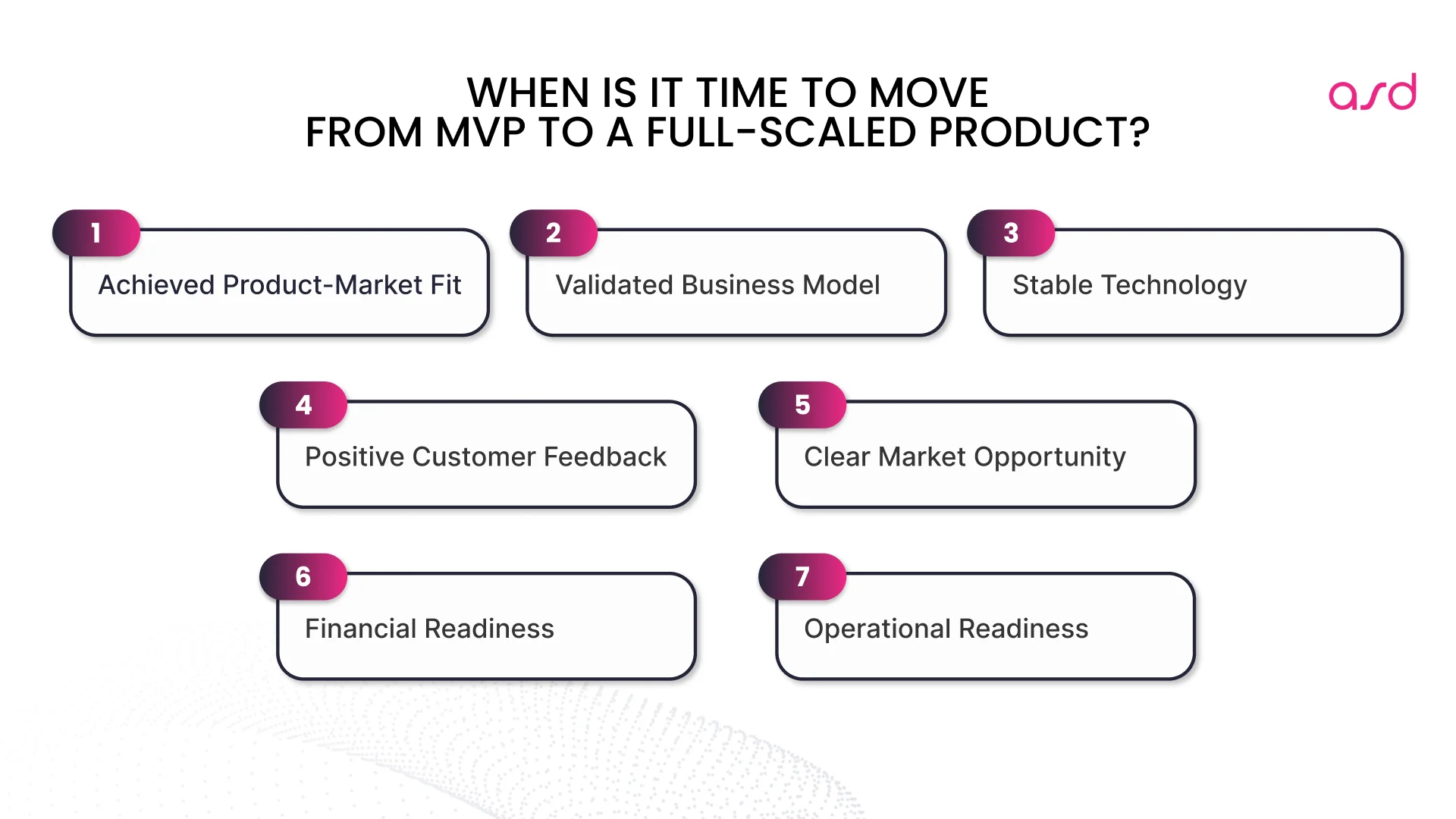
Сonclusion
Building an MVP (Minimum Viable Product) is a key step in the new product launch process, focusing on the most important features that address the core needs of your target audience. Following the MVP process is crucial as it allows you to quickly learn from early adopters and adapt your strategies based on their feedback. This strategy allows you to test your concept in the market with minimal costs, get valuable feedback, and evaluate the viability of the product. Thanks to this, you can reduce risks and form a clear plan for further development.
When moving from building MVP to scaling a full-scale product, it is extremely important to carefully analyze several key factors, such as user feedback, performance metrics, market demand, and financial readiness. Understanding these aspects will help you determine when and how to develop the product and effectively manage the scaling process.
So, building an MVP is a strategic move that provides a foundation for further successful scaling. By focusing on the core ideas of how to develop an MVP, analyzing the information gathered, and changing the product based on real-world feedback, you create the foundation for a reliable and scalable product that meets market needs and ensures long-term success.
The time to build an MVP varies based on complexity and scope, typically ranging from a few weeks to a few months.
No, an MVP is a functional version of your product with core features, while a prototype is an early, non-functional model used for testing ideas.
No, MVPs can be used by startups and established companies to test new ideas, validate concepts, and minimize risk.
Choose a company with experience in your industry, a proven track record, and strong communication skills. Review their portfolio and client feedback.
Transition when you have positive user feedback, met key performance indicators, validated market demand, and ensured financial readiness.
Use non-disclosure agreements (NDAs), limit access to sensitive information, and ensure that your development team follows strict confidentiality practices.
Avoid adding too many features, neglecting user feedback, failing to validate the market, and underestimating development time and costs.
Questions? Answers!
How long does it take to build an MVP?
The time to build an MVP varies based on complexity and scope, typically ranging from a few weeks to a few months.
Isn’t an MVP just a prototype?
No, an MVP is a functional version of your product with core features, while a prototype is an early, non-functional model used for testing ideas.
Is MVP only for startups?
No, MVPs can be used by startups and established companies to test new ideas, validate concepts, and minimize risk.
How do I choose the right software development company for my MVP?
Choose a company with experience in your industry, a proven track record, and strong communication skills. Review their portfolio and client feedback.
When should I start moving from MVP to a full-scale product?
Transition when you have positive user feedback, met key performance indicators, validated market demand, and ensured financial readiness.
How can I protect my MVP idea while I’m developing it?
Use non-disclosure agreements (NDAs), limit access to sensitive information, and ensure that your development team follows strict confidentiality practices.
What are some common mistakes to avoid while building an MVP?
Avoid adding too many features, neglecting user feedback, failing to validate the market, and underestimating development time and costs.


